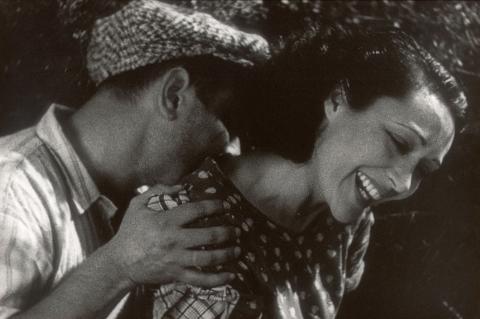TONI: Jean Renoir's Painterly Masterwork

TONI
These notes on Jean Renoir's Toni (1935) were written by David Vanden Bossche, PhD candidate in the Department of Communication Arts at UW-Madison. A 4K restoration of Toni will screen in our series of recent French film restorations on Friday, December 9 at 7 p.m. in the Cinematheque's regular screening venue, 4070 Vilas Hall, 821 University Ave. Admission is free!
By David Vanden Bossche
Which ‘Renoir’ is the most influential: father Pierre-Auguste Renoir, impressionist painter known for masterpieces such as Dance at Bougival and The Umbrellas, or son Jean Renoir whose films Rules of the Game (La Règle du Jeu, 1939) and La Grande Illusion (1937) regularly feature on lists naming the greatest films of all time? It’s a question that remains up for debate, preferably over a good glass of French wine or absinthe.
Whatever the case, there’s no denying Jean Renoir’s standing as one of the most important French filmmakers of the twentieth century, his towering achievements as a director far outnumbering the limited amount of titles that found their way into the public cultural memory. Few directors can boast ever having made a film like La Bête Humaine (1938) let alone line that one up with the aforementioned classics and films like The River (1951), The Crime of Monsieur Lange (1936), The Golden Coach (1952) or arguably his most famous film among casual movie viewers: A Day in the Country (Une Partie de Campagne, 1946).
Missing from that list – among many others – is Toni from 1935, another one of Jean Renoir’s master classes in filmmaking.
In his book Film History, Peter von Bagh labeled this rural drama as a direct predecessor to the Italian neo-realism that would revolutionize film art about a decade later. To a certain degree that is true – Renoir admitted that he wanted to convey a high degree of naturalism in Toni – but if we look at Italian neo-realism along the lines of Gilles Deleuze’s ideas of this being the moment when cinema drastically re-conceptualized the notion of ‘time’, then Toni is a different beast altogether. ‘Time’ and ‘Temps Mort/ Dead Time’ became the main element around which films like Bicycle Thieves (1948) and Umberto D. (1952) were centered – a notion recently powerfully reiterated in Jordan Schonig’s book The Shape of Motion – and this element is decidedly absent from Toni’s dramatic arc, which is much more akin’ to classic storytelling than anything that came out of Italian neo-realism. Much more than a predecessor to the Italian movement, Toni, with its penchant for heightened lyrical realism, is part of the ‘French Poetic Realism’ that would go on to dominate the next decade with such famous titles as Marcel Carné’s Port of Shadows (Quai des Brumes, 1938) and Children of Paradise (Les Enfants du Paradis, 1945).
Toni’s plot is based on the writings of Jacques Levert (who plays a minor uncredited part), a retired French police commissioner from the Martigues region near Marseille – the same region where the film was shot – and tells the story of a tragedy that unfolds among the migrant populace in the south of France. This is primarily a love story, but the grim social reality and hostile environment in which the drama takes place is an integral part of the cinematic universe Renoir creates here. Anchored in a bleak view of humanity, Toni surely is one of Renoir’s most pessimistic films, offering little redemption for the characters, or the viewer for that matter. Focusing on the love story between an Italian migrant worker (Charles Blavette) and a local young girl (Celia Montalván), the film brings questions to the fore about race, class and economical hardship that certainly struck a chord with contemporaneous French audiences but also proved to have a universal appeal for 1930s audiences worldwide. In a 1956 issue of Les Cahiers du Cinéma, Renoir addressed this success by stating that ‘I would be happy if you could fathom just a little bit of my love for this Mediterranean community’. It seems he did more than that, as viewers anywhere were more than willing to sympathize with the tragic protagonist.
The black and white cinematography in Toni is by Claude Renoir, the director’s nephew who would subsequently work with him on a few more projects and become a prolific director of photography signing off on high-profile titles like The French Connection II (1975) and The Spy Who Loved Me (1977). The most remarkable name attached to this project, however, is Luchino Visconti’s , the future director of bona fide classics such as Rocco and his Brothers (1960), The Leopard (1963) and Death in Venice (1971), to name but a few. Visconti served as an uncredited assistant director on Toni and later never ceased to mention how much he had learned about cinema and directing from the great Jean Renoir.
Toni may not contain the ‘bravura’ shots that people have come to associate with Renoir based on La Grande Illusion or La Règle du Jeu, but the more timid register in which the director works here is just as interesting and visually overwhelming, drawing from more painterly influences that would remain a mainstay in Renoir’s oeuvre, through his ‘Hollywood’ period (1941's Swamp Water being a prime example) and later on in movies like The River, or his homage to his father’s work in 1959’s Picnic in the Grass (Déjeuner sur L’Herbe, 1959).
The film was splendidly restored in 4K at the‘L’Immagine Ritrovato laboratory in Bologna and premiered at the 2019 edition of the annual Il Cinema Ritrovato festival.
